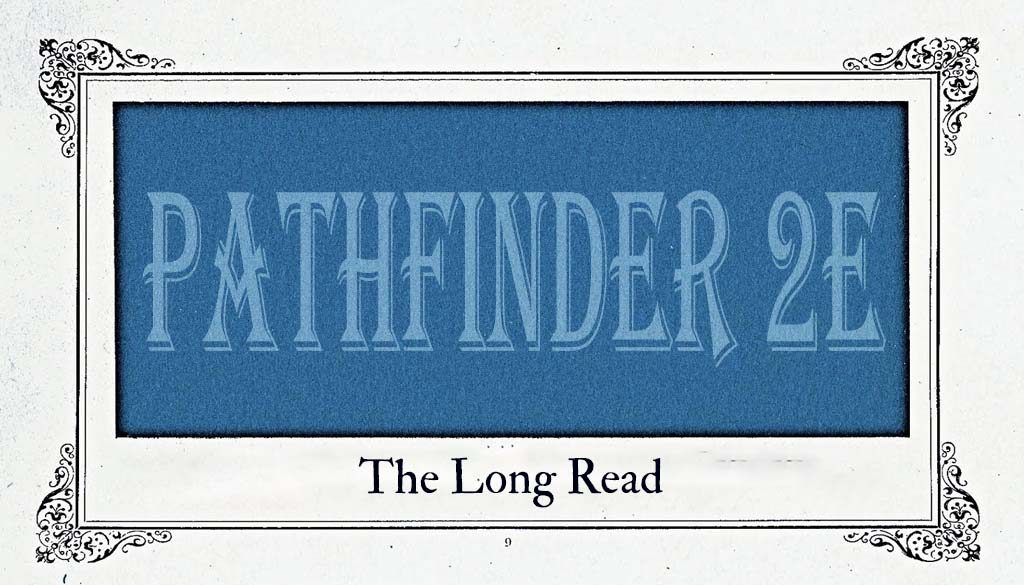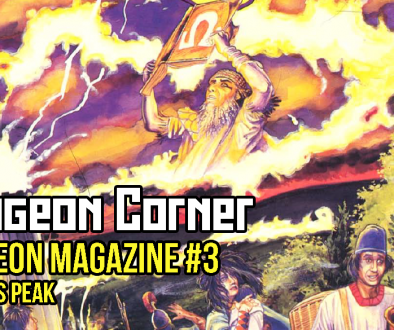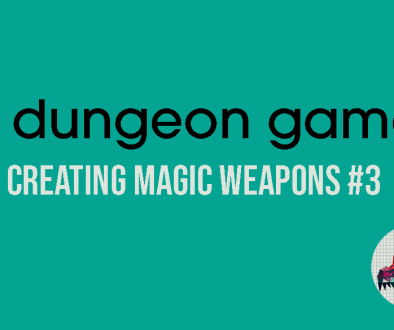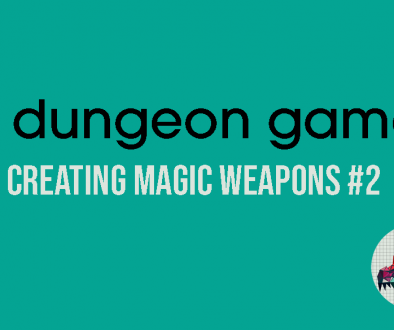The Long Read: Pathfinder 2e
This is a mirror of this Twitter thread, which was written in real time as I read Pathfinder 2nd Edition. It hasn’t been edited in any way. If you decide to pick up Pathfinder 2e I’d appreciate it if you considered using my affiliate link, which lets me earn some money from your purchase. You can also leave a tip at Ko-Fi if you like this kind of content and want to see more of it. Thanks for reading.
Saw a thread a few days ago talking about 5 strengths of Pathfinder 2e that took me from “not at all interested” to… Well…

Going to peruse it and maybe leave some thoughts in thread as I read but
A) this isn’t a review and
B) I don’t have the spoons for a discussion so while you’re welcome to reply, I might ignore it
Immediate thought: I hate D&D model of calling something a core rulebook but not including everything you need to play the game. Put monsters in your core rules if your game features monsters heavily.
Especially Pathfinder, where the monster designs are so cool. Show that off! You gain a level every 1000 XP. I’m curious to know what XP is awarded for, in that case. My guess is that it’s no longer tied to killing things or that the CR/monster xp system has been drastically reworked. That’s interesting. And we’ve dropped Race in favour of Ancestry.
Good. Crit successes and failures on skill checks exist which is an interesting decision. I like the pass/fail by 10 or more as a crit thing. I already don’t like “not all checks have a special effect on a crit”. We’re on page 10 and already introducing edge cases and complexities. We’ve got the Proficiency bonus and since it’s Pathfinder there’s maths involved.
Your Proficiency bonus = your Proficiency rank (2, 4, 6, or 8) and your level. And then you add your ability modifier, too. So that’s 3 modifiers to every roll. Part of me hates this and part of me loves that you immediately get better at things just by levelling up. I’d have to play it to know how I actually feel
We’ve got three Actions per round, plus a Reaction, and Free Actions. I’m a fan of three Actions per round; two can often feel limiting, and in 5e terms most characters get a bonus action of some kind anyway and functionally do 3 things per round. Little quality of life things I like: Attack Actions are called Strikes. So much confusion is caused by the capital-A Attack action Vs ‘attack’ as a verb so this is a nice adjustment. Proficiency affects AC.
Yay, more maths. Multiple Strikes on a round incur increasing penalties to hit which…okay, fine. I’m sure there’s classes and feats that don’t do this so you get to feel special.
BurnBryte still has the best system for handling multiple actions each turn. Downtime mechanisms being right up front in the rules is fun, and I like that it’s got retraining built into it. Pathfinder has always had a culture of RAW among its player base so this heads off dickhead GMs forcing you to stick to choices you aren’t happy with. Very interested to get to the downtime section and see what’s actually going on but I’m not going to skip ahead. We’re still using Level to refer to character levels (and monster levels – I guess CR is gone) and Spell Levels and I hate that and will always hate that.
Pick a new name for spell levels. It’s needlessly confusing for people. There’s a lot to be said for the visual consistency of Paizo’s products over the years, btw. If you showed me a random page of this book I’d know it was Paizo. If feels like I’m reading Dragon magazine again. They buried the lede when they were talking about Actions. “Casting a spell is an activity that usually uses two actions”. WHY
I really hate this whole “you can only cast one spell per turn” nonsense and don’t have the energy to get into why right now. But I hate it. Something in the example of play that hasn’t been mentioned yet: secret checks that the GM rolls for the players.
Looking for traps is a secret check & tbh I like that. It immediately that nonsense of someone failing a roll and everyone else immediately making the same check. This is actually a cool example of play as it’s introducing rules concepts we haven’t encountered yet in an organic way. Initiative isn’t a straight Dexterity check, it’s based on what you’re doing at the start of combat. So you can roll Stealth for initiative if you’re hiding. Okay, had an extended break to do chores but I’M BACK BABY
I really like these symbols, they’re nice and clear and I can imagine having your character’s abilities on a deck of cards and just playing them on the table each round to keep track of what you’ve done.

My only gripe is that I know I’d get that Free Action symbol confused with Single Action. The stat blocks for actions, feats, etc really remind me of the way Powers were presented in 4e. Nice and clear and, in theory, unambiguous
On the other hand, this crowded character sheet breaks my brain:

“All the steps of character creation are […] Marked with a number that corresponds to the sample character sheet […] Showing you where the information goes. If the field you need to fill out is on the 3rd or 4th page of the character sheet, which aren’t shown…”
Show them. If you’re going to give a visual example of something like a complex character sheet it’s not good enough to only give visuals for half of the sheet. Don’t do half a job
So we changed Race to Ancestry but we still have bioessentialism in the form of heritage-based Ability Boosts and Ability. Cool. Cool cool cool. Very interesting that rolling ability scores is relegated to an alternative method. Abilities as standard are built by plugging in numbers from your Ancestry, Background, and Class, and then boosting another 4 of your choice. I can definitely see the benefit in a game so obsessed with maths and balance of having everybody start on a level playing field like this, and I prefer it to a point buy system, but you’ll never get me to stop rolling ability scores where I have the option.
I can’t begin to explain the extent to which is this diagram breaks my brain.

I’m skipping this section because if my short-lived Naming The Faceless series taught me anything it’s that I can’t parse character creation instructions just by reading them, I need to physically male a character, and that’s not something I’m about to do. I do like how many Ancestry Feat options you get at first level. There’s a lot of variance here outside of class abilities and that’s really cool. I really like the Titan Slinger feat that Halflings can choose and I don’t know why I like this one specifically. It’s fun though
Interesting that Half Elves and Half Orcs are subtypes of Human
Very weird that there’s only one 1st Level half elf feat Vs five for half orcs
In fact the number of half elf feat seems really, really limited compared to every other Ancestry. One 1st Level feat and two 5th Level and that’s it. Weird.
Pathfinder art is just fun, isn’t it?

I like that the Class entries explicitly call out what role these classes play in combat, in social encounters, while exploring, and in downtime. One thing I’ll say for 2e is that it’s doing a good job of telling me what they expect a standard Pathfinder game to look like. D&D doesn’t really do that – it often reads like it’s built with the expectation that you already know how to play. Pathfinder doesn’t seem to be making that assumption here. I also really like how many sample builds they give you for each class so you can get an idea of how to take these abilities and make something interesting.
As much as it’s maths-heavy and rules dense, I think this book does a good job of hand-holding players. Personally I find it easy to feel overwhelmed by big games and I’m honestly not really getting that here, which is nice
Lol I say “all these sample characters are great” and then I hit the Bard, generally my preferred class, and there’s only one sample.
The lack of consistency with this stuff bothers me. Either I’ve missed something, or this Concentrate tag hasn’t been explained anywhere yet. This is the first time I’ve hit something where I’ve bounced off because I don’t know what it means. To the Glossary!

“Concentrate [trait] An action with this trait requires a degree of mental concentration or disclipline.”
That’s not helpful. Is this a mechanical effect? Is it just flavour? I have no idea.

Having looked everywhere I can conceivably think of for a definition of “Concentrate” in game terms…there isn’t one. I assume it doesn’t have a mechanical effect and it’s just there to tell the GM “this can’t be done under pressure” but that isn’t spelled out anywhere. This is one of those things where in a rules light game, it wouldn’t matter. But Pathfinder is crunchy. It has rules for every eventuality. It expects you to play RAW. And the fact that this tag exists but isn’t defined is a problem. Still, it took 200+ pages for me to hit something like this, so that’s good going really
If you’re about to roll into my replies [or my comments on this blog] to explain something to me: Don’t.
I hate this paragraph, to be honest. It’s the “just homebrew it” thing all over again. This is a mechanically complex game. Why are we meant to accept “these rules might not work” 440+ pages into a 600 page book?

This is always the problem with dense games and it’s one of the reasons I don’t play them often. The more rules you have the more weird interactions there are. There’s simultaneously less room for interpreting rules as you see fit but also more need for it when they fail. Feeling a need to slap a big IN MY OPINION sticker on those last couple of tweets despite that being self-evident
I’m onto the Playing The Game section now. I’ve heard from a few people that they struggle with the +10 over DC crits because they need to account for two possible degrees of success (and similarly for fail) and that’s really interesting to me. As someone who’s played a lot of FitD and PbtA games, degrees of success isn’t something I struggle with but I remember finding it a bit weird when I first started playing those kinds of games having only been used to binary success/failure in D&D. What helped me was the PbtA phrasing of mixed success and full success, and I wonder why PF2e has gone with Success and Critical Success Vs mixed success and full success.
(Obviously the answer is “because Crits are already a thing in PF1e”)
But I wonder how much easier this would be for people who are only used to binary pass/fail if it was couched in terms that are closer to PbtA, rather than using the language of Critical Success and failure. Anyway, back to the actual mechanics.
I like that a natural 1 or 20 isn’t an instant pass/fail but rather just changes the result by a degree of success. I bet there’s a learning curve with that for people used to 1e and D&D, though. Three pages to explain how to deal damage.
Ahhh, Pathfinder. I’m honestly not sure why the game needs both Emanation and Burst effects. Bursts go from the corner of a square, and Emanations go from each side of your square, so they’re slightly different (Emanations are slightly bigger) but… Yeah. I don’t see the need, to be honest. It seems like needless complexity. I guess an Emanation is contingent on the size of the creature creating it – a Large creature Emanates from 4 squares and a Medium creature from 1 – whereas a Burst always goes from a single spot.
But still. I don’t like it. I do quite like the death mechanics in this game. The push/pull of increasing and decreasing your Dying condition feels way more gripping than e.g. 5e’s Best Of 5 Death Saves. Yes, it’s more bookkeeping, but I like it. I do question why it took until page 460 to learn about Hero Points, though.
Got to the Downtime section that I was so interested in. It’s a single page that basically says “you can swap equivalent feats and Skills that you aren’t happy with during downtime”. Which is fine, and refreshingly light on rules for this game. It’s a shame that Downtime is explicitly called out as one of the three modes of play at the start of the book and only gets a page, though. All the interesting stuff is under this one paragraph that just says, “Ask your GM”

The Game Mastering section opens with safety tools, stuff about the social contract and discussing what kind of content will be in the game, and explicit instructions that Pathfinder PCs should never engage in torture, rape, sexual assault, harm to children, or slavery. That’s good
There’s also sidebars about safety tools and about including characters with disabilities. I’m not qualified to speak on whether that sidebar is any good or not, but I think it’s fair to say that it’s good that a major game like this bothered to include something like that. Finally my questions about XP and encounter building are answered. This isn’t too dissimilar to the way encounters are built in PF1 and 5e, really. Without a bestiary in the book, though, this is all largely academic. I am aware that the book points you to a website with monsters, which I haven’t looked at, but again I’m saying PUT A BESTIARY IN YOUR CORE RULES IF YOUR GAME IS ABOUT KILLING THINGS. And before anyone tells me this game isn’t about killing things, I direct you to page 488:
“The most common type of encounter is a combat encounter, where the PCs face other creatures.”
The book explicitly tells us that most of the time we play we’re expected to be interacting with this specific part of the game, and then doesn’t give us everything we need to run that part of the game. You will never convince me not to hate that. I’m glad that magic items and traps are given so much space in here. Honestly if this book had some monsters it would be everything you need to run the game and that’s great. It’s a big improvement over the 3 book D&D model. But still not quite there.
Anyway I think I like Pathfinder 2e? I’ll have to play it to be sure but there’s very little in here that I immediately bounced off, so that’s cool. Maybe I’ll fuck around and build a character at some point.
This is a mirror of this Twitter thread, which was written in real time as I read Pathfinder 2nd Edition. It hasn’t been edited in any way. If you decide to pick up Pathfinder 2e I’d appreciate it if you considered using my affiliate link, which lets me earn some money from your purchase. You can also leave a tip at Ko-Fi if you like this kind of content and want to see more of it. Thanks for reading.





The Long Read: 13th Age – Loot The Room
October 5, 2021 @ 4:32 pm
[…] with the Pathfinder 2 thread the other week, this is just my initial impressions. It’s not a review – […]